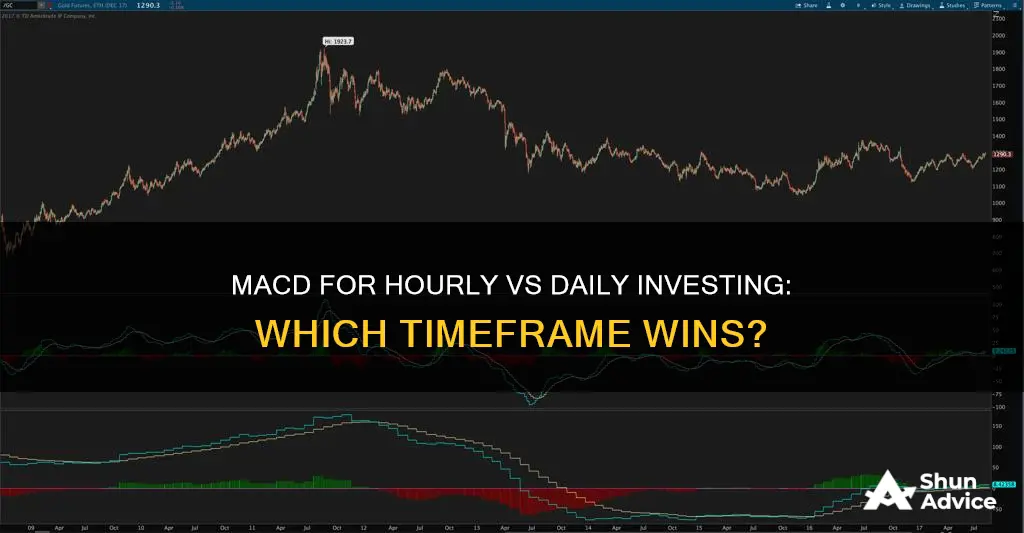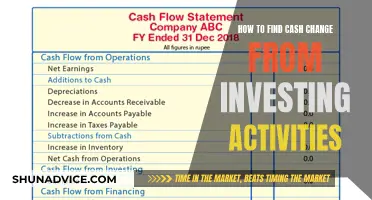
The MACD (Moving Average Convergence Divergence) is a popular tool used by traders to identify price trends, measure trend momentum, and determine entry points for buying or selling. It is a trend-following momentum indicator that shows the relationship between two exponential moving averages (EMAs) of a security's price. The MACD line is calculated by subtracting the 26-period EMA from the 12-period EMA, and the signal line is a nine-period EMA of the MACD line.
The MACD can be used with different timeframes, such as hourly or daily charts, and the choice depends on the trader's strategy and objectives. Hourly MACD will react more quickly to price changes, while daily MACD captures broader market trends and helps filter out market noise.
Traders use the MACD to identify buy and sell signals based on the interaction of the MACD line and the signal line. A common strategy is to buy when the MACD line crosses above the signal line, indicating bullish momentum, and to sell when it crosses below, indicating bearish momentum.
While the standard settings for the MACD are 12, 26, and 9, traders can adjust these settings to suit their specific strategies and timeframes. For example, day traders might use shorter periods, such as 8 or 9 days, to respond more quickly to price movements.
| Characteristics | Values |
|---|---|
| Type of indicator | Momentum and trend-following |
| Creator | Gerald Appel |
| Date created | 1970s |
| Data used | Historical price action |
| Timeframes | Hourly, daily, weekly, monthly |
| Default settings | 12, 26, 9 |
| Lines | MACD line, signal line |
| Calculation | MACD = 12-day EMA - 26-day EMA |
| Signal line calculation | 9-day EMA of the MACD line |
| Histogram calculation | Histogram = MACD - Signal Line |
| Bullish signal | MACD line crosses above signal line |
| Bearish signal | MACD line crosses below signal line |
What You'll Learn

The MACD line, signal line, and histogram
The MACD line is calculated by subtracting the 26-period exponential moving average (EMA) from the 12-period EMA. This creates a line that fluctuates above and below the zero line as the moving averages converge, cross, and diverge. A positive MACD value indicates positive momentum, while a negative value indicates negative momentum.
The signal line is a nine-period EMA of the MACD line and is plotted on top of it. It serves as a trigger for buy or sell signals. Traders may buy a security when the MACD line crosses above the signal line and sell when it crosses below.
The MACD histogram represents the difference between the MACD line and the signal line, displayed as a bar chart that oscillates above and below a zero line. It is used to identify peaks of bullish or bearish momentum and to generate overbought/oversold trade signals. A rising histogram indicates increasing momentum, while a falling histogram suggests decreasing momentum.
The MACD indicator is a versatile tool that can be interpreted in several ways, including crossovers, divergences, and rapid rises/falls. It helps investors identify price trends, measure trend momentum, and determine entry and exit points for trades.
Investing: Negative Cash Flow's Impact and Insights
You may want to see also

How to trade MACD crossovers
The MACD (Moving Average Convergence/Divergence) is a technical indicator that helps investors identify price trends, measure trend momentum, and pinpoint entry points for buying or selling. It is a trend-following momentum indicator that shows the relationship between two exponential moving averages (EMAs) of a security's price.
The MACD line is calculated by subtracting the 26-period EMA from the 12-period EMA. The signal line, which is plotted on top of the MACD line, is a nine-period EMA of the MACD line.
Traders may buy a security when the MACD line crosses above the signal line and sell or short-sell the security when the MACD line crosses below the signal line. This is known as a MACD crossover.
- Conformity with the prevailing trend: Crossovers are more reliable when they conform to the prevailing trend. For example, if the MACD crosses above the signal line after a brief downside correction within a longer-term uptrend, it confirms bullish momentum and the likely continuation of the uptrend.
- Confirmation from other indicators: While MACD crossovers are useful indicators, they should not be the sole reason for entering a trade. It is recommended to seek confirmation from other technical indicators, such as the Relative Strength Index (RSI), or candlestick price charts, to strengthen your thesis and avoid false signals.
- Timing and speed of the market: The MACD is a lagging indicator, which means it is based on historical price data. This can result in delayed signals, especially in fast-moving, choppy markets. Therefore, it is important to monitor the MACD indicator closely to receive signals as quickly as possible.
- Combining with other strategies: Combining MACD crossovers with other MACD strategies, such as histogram reversals or zero crosses, can provide a more comprehensive view of the market.
- Divergence with price: Pay attention to whether the MACD is diverging with price. For example, if the 1-hour or 144-minute to 2-hour MACD has been diverging with price over the last trading day or two, it could be a warning sign to consider taking profits.
- Volume and fundamental analysis: While technical analysis is crucial, it should be complemented by volume, fundamental analysis, and other indicators to make more informed trading decisions.
In conclusion, MACD crossovers are valuable tools for traders, but they should be used in conjunction with other indicators and analysis to make well-timed and informed trading decisions.
Cashing Out Your Fidelity Investments: A Step-by-Step Guide
You may want to see also

How to trade MACD divergences
MACD divergence is a trading strategy that can be used to predict trend reversals and identify specific entry and exit points in the market. It is a momentum indicator that shows the relationship between two moving averages of an asset's price.
To calculate MACD, subtract the 26-period exponential moving average (EMA) from the 12-period EMA. The result is the MACD line, which is plotted on a chart below the price chart. On the indicator, you will also see a 9-period EMA of the MACD, which is referred to as the 'signal line'.
Bullish Divergence
A bullish divergence occurs when the MACD makes two rising lows that correspond to two falling lows in the stock price. This is a valid bullish signal when the long-term trend remains positive.
Bearish Divergence
A bearish divergence occurs when the MACD makes two falling highs that correspond to two rising highs in the stock price. This is a valid bearish signal when the long-term trend remains negative.
When using the MACD divergence strategy, it is important to combine it with other indicators and price action for confirmation. Some traders also use shorter timeframes, such as 30-minute or 1-hour charts, to confirm momentum divergence.
- Trend Identification: Determine the direction of the trend and when it might be coming to an end. Look for higher highs and higher lows in an upward-trending market, and lower lows and lower highs in a downward-trending market.
- Corrections and Market Geometry: Anticipate where corrections might appear by using tools such as the Fib Extension tool to project levels where support or resistance is expected.
- Using the MACD Histogram for Trade Confirmation: This is the most crucial step. Look for momentum divergence, where the MACD-Histogram starts to divert from what the price is doing. For a bullish signal, look for the opposite of what is described in the 'Bearish Divergence' above.
- Trade Entry and Management: Once the MACD confirms that the conditions are right, place your order. Typically, there are two targets: the first target is placed at the low of the correction, and the second target is placed at the lower warning line.
It is important to note that MACD divergence, when used on its own, may not provide accurate signals for trend reversals. Therefore, it should be combined with other indicators and a solid trading strategy.
QuickBooks Owner Investment: Where Does Cash Fit?
You may want to see also

How to use the MACD histogram
The MACD histogram is a tool used to predict price fluctuations and trend reversals. It is calculated by subtracting the signal line from the MACD line. The histogram is positive when the MACD is above its signal line and negative when it is below.
The MACD histogram is useful for identifying potential trend reversals and price swings. When the histogram is positive, it means that the MACD is higher than its nine-day average, indicating a recent increase in upward momentum. Conversely, when the histogram is negative, the MACD is lower than its nine-day average.
The histogram turns towards the zero line when the MACD and signal line converge, indicating a potential shift in the market. This can be used by traders to make informed decisions.
When using the MACD histogram, it is important to consider other indicators as well, as it is less reliable on its own. For example, signals are stronger if there is a bullish divergence on the histogram or if the signal occurs far from the zero line. It is recommended to disregard signals close to the zero line unless confirmed by a divergence.
The MACD histogram can also be used to track longer cycles and identify trading signals by combining it with other indicators. For instance, traders may go long when the histogram turns up below zero and go short when it turns down above zero.
Understanding the Cash Flow Statement: Operations, Investments, and Financing
You may want to see also

How to use MACD with RSI and SMA
The Moving Average Convergence/Divergence (MACD), Relative Strength Index (RSI), and Simple Moving Average (SMA) are technical indicators that can be used together to identify strong trading signals.
The RSI is a leading oscillator, meaning it shows potential future price changes. It is measured on a scale of 1 to 100, with readings above 50 suggesting market bullishness, and readings below 50 indicating market bearishness. The RSI compares bullish and bearish price momentum plotted against the graph of an asset's price. It calculates the average price gains and losses over a given period of time, with the default being 14 periods. A reading above 70 suggests an overbought condition, while a reading below 30 is considered oversold.
The MACD is a lagging indicator that calculates the relationship between two exponential moving averages (EMAs) of a stock price. It is calculated by subtracting the 26-period EMA from the 12-period EMA, and a nine-day EMA of that calculation is plotted as the signal line. The MACD triggers technical signals when it crosses above (to buy) or below (to sell) its signal line.
The SMA is a lagging, trend-following indicator. It is used to identify whether the price is above or below the average rate for a certain number of periods.
Combining these three indicators can provide stronger trading signals. For example, when the RSI gives a buy signal, traders can look for confirmation from the MACD and SMA. In a buy signal, the RSI baseline would be above 50 and moving up, the candlestick chart would cross the SMA line from below and move above it, and the MACD indicator would show a buying signal with the shorter-term EMA crossing above the longer-term EMA.
It is important to note that no indicator or strategy can guarantee 100% success, and there is always a risk of false signals. Additionally, patience is key when using this strategy, as waiting for all three indicators to align can take time. It is also recommended to have a good understanding of each indicator individually to use them effectively together.
Cashing in on Treasury Investment Growth: Receipt Redemption Guide
You may want to see also
Frequently asked questions
MACD stands for Moving Average Convergence/Divergence. It is a trend-following momentum indicator that shows the relationship between two exponential moving averages (EMAs) of a security's price.
The MACD line is calculated by subtracting the 26-period EMA (the slower EMA) from the 12-period EMA (the faster EMA). The signal line is a nine-period EMA of the MACD line.
The standard MACD settings are 12, 26, and 9. The first two numbers refer to the faster and slower EMAs, respectively, and the last number is the signal line.
The MACD can be used on any time frame, including hourly and daily charts. The settings can be adjusted to suit your specific strategy and time frame. For hourly charts, a faster MACD setting is recommended, while the default settings of 12, 26, and 9 are often used for daily charts.







